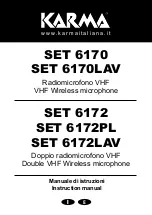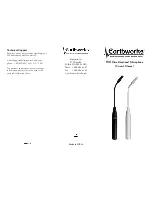
Batteriefach angegeben, einsetzen und die Schraub-
kappe wieder aufschrauben.
Bei Einsatz mehrerer Funksysteme bietet sich
zur farblichen Kennzeichnung der Mikrofone das
Codierringe-Set TXS-880CC von „img Stage Line“
an: Den schwarzen Ring (22) am Mikrofonende ab-
ziehen und einen der farbigen Ringe des Sets auf-
setzen.
5.4 Empfänger und Sender auf den gleichen
Übertragungskanal einstellen
1) Den Empfänger mit dem Schalter (1) auf der
Frontseite einschalten. Im eingeschalteten Zu-
stand leuchtet der Schalter und das Display (2)
zeigt den Übertragungskanal an.
2) Mit der Taste CHANNEL (3) den gewünschten
Kanal auswählen. Es stehen 16 Kanäle (0 – 9,
A – F) zur Verfügung, mit jedem Tastendruck wird
auf den nächsten Kanal gesprungen. Dabei wer-
den Kanäle, auf denen zur Zeit gesendet wird,
übersprungen.
3) Den Sender mit dem Schiebeschalter (17) ein-
schalten. Die Kontroll-Lampe (16) am Sender
zeigt den Ladezustand der Batterie an:
a LED leuchtet beim Einschalten kurz auf und
erlischt danach:
die Batterie ist noch ausreichend geladen
b LED leuchtet nach dem Einschalten bzw.
während des Betriebs auf und erlischt nicht:
die Batterie ist nicht mehr ausreichend gela-
den und sollte ausgetauscht werden
c LED leuchtet nach dem Einschalten nicht:
keine Batterie eingesetzt bzw. die Batterie ist
erschöpft oder falsch eingesetzt
4) Den Sender so positionieren, dass sich der Infra-
rot-Empfangssensor (18) max. 20 cm entfernt in
Höhe der Infrarot-Sendediode (5) des Empfän-
gers befindet.
5) Am Empfänger die Taste ACT (4) [ACT = „Auto-
matic Channel Targeting“] drücken. Während des
Einstellvorgangs blinkt die Kanalanzeige (2).
6) Wenn die Kanalanzeige nicht mehr blinkt und die
Anzeige RF (6) ein Empfangssignal anzeigt, sind
Sender und Empfänger auf den gleichen Über-
tragungskanal eingestellt.
Hinweis zum Kanalwechsel:
Wird während des Betriebs mit der Taste CHANNEL
auf einen anderen Kanal gewechselt, lässt sich der
Empfänger bei eingeschaltetem Sender nicht zu-
rück auf den vorher eingestellten Kanal schalten:
Das Gerät erkennt, dass dieser Kanal bereits vom
Sender belegt ist und überspringt ihn beim Durch-
schalten der Kanäle mit der Taste CHANNEL. Um
den Empfänger wieder auf den vorher eingestellten
Kanal zurückzuschalten
a entweder den Sender ausschalten, am Empfän-
ger mit der Taste CHANNEL den vorher einge-
stellten Kanal anwählen und den Sender wieder
einschalten
b oder die Taste CHANNEL gedrückt halten. Alle
Kanäle, auch die belegten, werden dann durch-
laufen. Sobald im Kanaldisplay der vorher einge-
stellte Kanal angezeigt wird, die Taste lösen.
6
Bedienung
1) Den Empfänger mit dem Schalter (1) auf der
Frontseite einschalten. Der Schalter leuchtet und
das Display (2) zeigt den eingestellten Übertra-
gungskanal an.
2) Um die Ansprechschwelle für die Störunterdrü-
ckung einzustellen, den Sender vorerst noch aus-
geschaltet lassen. Den Regler SQUELCH (13) mit
einem kleinen Schraubendreher entgegen dem
Uhrzeigersinn bis zum Anschlag drehen. Leuchtet
nur die Empfangsanzeige RF (6) auf, werden Stö-
rungen empfangen, die über die Squelch-Schal-
tung (Pilottonverfahren & Noise Lock) unterdrückt
werden. Leuchten sowohl die Empfangsanzeige
RF (6) als auch die Lautstärkeanzeige AUDIO (7),
auf, den Regler SQUELCH gerade so weit in
Pfeilrichtung aufdrehen, bis die AUDIO-Anzeige
nicht mehr leuchtet. Den Regler danach nicht
weiter aufdrehen, sonst wird eventuell auch das
Sendesignal unterdrückt.
3) Den Sender mit dem Schiebeschalter (17) ein-
schalten. Die Kontroll-Lampe (16) am Sender
zeigt den Ladezustand der Batterie an, siehe
dazu Kap. 5.4, Punkt 3.
4) Sind Sender und Empfänger auf unterschiedliche
Übertragungskanäle eingestellt [Balkenanzeige
RF (6) leuchtet nicht], muss der Sender per Infra-
rot-Übertragung auf den Kanal des Empfängers
programmiert werden, siehe dazu Kap. 5.4.
Sind Sender und Empfänger auf den gleichen
Übertragungskanal eingestellt, zeigt der Emp-
fänger den Empfang des Funksignals über die
Anzeige RF (6) an: je mehr Segmente der An-
zeige leuchten, desto besser ist der Empfang.
Ist der Empfang zu schwach, überprüfen ob
a die Batterie des Senders nicht mehr ausrei-
chend geladen ist [Kontroll-Lampe (16) am
Sender leuchtet permanent rot].
b der Abstand zwischen Sender und Empfänger
zu groß ist.
c der Empfang durch Gegenstände in der Über-
tragungsstrecke gestört ist
d sich der Empfang durch Schwenken der An-
tennen verbessern lässt.
e die Rauschsperre mit dem SQUELCH-Regler
(13) zu hoch eingestellt ist (siehe Punkt 2).
5) Das nachfolgende Audiogerät einschalten bzw.
den entsprechenden Mischpultregler aufziehen.
6) In das Mikrofon sprechen/singen bzw. das Musik-
instrument spielen. Die Lautstärke des vom Sen-
der empfangenen Audiosignals wird am Empfän-
ger über die Anzeige AUDIO (7) angezeigt: je
mehr Segmente der Anzeige leuchten, desto hö-
her ist der Lautstärkepegel. Bei dem Taschen-
sender TXS-880HSE lässt sich die Lautstärke für
ein angeschlossenes Mikrofon über den Trimm-
Regler GAIN (19) korrigieren [der Regler ist nur
wirksam, wenn der daneben liegende Schalter
(20) auf „MT“ steht]: Den Batteriefachdeckel (15)
aufklappen, den Regler mit einem kleinen Schrau-
connection see fig. 7a). An electric guitar can be
directly connected via the cable MCA-880G
(6.3 mm plug to mini XLR inline jack) available as
an accessory.
3) Set the impedance selector (20) according to the
signal source connected:
“MT” with a microphone connected
“GT” with an electric guitar connected
4) Close the cover of the battery compartment.
5.3 Hand-held microphone TXS-880HT:
Power supply, accessories
Unscrew the screw cap (21) at the lower end of the
microphone. This will allow access to the battery
compartment. Insert a 9 V battery with the positive
and negative connections as indicated in the battery
compartment. Replace the screw cap.
If several wireless transmission systems are
used, it is recommended to use the set of coding
rings TXS-880CC by “img Stage Line” for identifying
the microphones by colours: Remove the black ring
(22) at the lower end of the microphone and replace
it by one of the coloured rings of the set.
5.4 Setting the receiver and the transmitter to
the same transmission channel
1) Switch on the receiver with the power switch (1)
on the front panel. With the receiver switched on,
the switch will light up and the display (2) will
show the transmission channel.
2) With the button CHANNEL (3), select the desired
channel. 16 channels (0 – 9, A – F) are available.
Each time the button is pressed, the next channel
is selected. Channels where transmission is
made at the time being will be skipped.
3) Switch on the transmitter with the sliding switch
(17). The indicating LED (16) on the transmitter
shows the charging status of the battery:
a LED shortly lights up when the unit is switched
on and is then extinguished:
the battery is sufficiently charged
b LED lights up when the unit is switched on or
during operation and is not extinguished:
the battery is not sufficiently charged any
more and should be replaced
c LED does not light up when the unit is
switched on:
no battery is inserted or the battery is ex-
hausted or not correctly inserted
4) Position the transmitter in such a way that the
infrared reception sensor (18) is at a maximum
distance of 20 cm on the level of the infrared
transmission diode (5) of the receiver.
5) Press the button ACT (4) [ACT = automatic chan-
nel targeting] on the receiver. During the adjusting
process, the channel indication (2) will flash.
6) If the channel indication stops flashing and the
indication RF (6) shows a reception signal, the
transmitter and the receiver have been adjusted
to the same transmission channel.
Note concerning channel selection:
If, during operation, another channel is selected with
the button CHANNEL, it will be impossible to switch
the receiver to the previous channel while the trans-
mitter is switched on: The unit will recognize that this
channel is already used by the transmitter. Thus, this
channel is skipped when the channels are scanned
with the button CHANNEL. To reset the receiver to
the previous channel
a either switch off the transmitter, select the pre-
vious channel on the receiver with the button
CHANNEL and switch on the transmitter again
b or keep the button CHANNEL pressed. All chan-
nels, including the ones that are being used, will
be scanned. As soon as the channel display in-
dicates the previous channel, release the button.
6
Operation
1) Switch on the receiver with the power switch (1)
on the front panel. The switch will light up and the
display (2) will show the transmission channel
adjusted.
2) To adjust the threshold of noise suppression,
keep the transmitter switched off for the time
being. Use a small screwdriver to turn the control
SQUELCH (13) counter-clockwise to the stop. If
only the reception indication RF (6) lights up,
noise is received which is suppressed via the
squelch circuit (pilot tone procedure & noise lock).
If both the reception indication RF (6) and the
volume indication AUDIO (7) light up, advance
the control SQUELCH carefully in arrow direction
until the AUDIO indication is extinguished. Do not
further advance the control, otherwise the trans-
mission signal may be suppressed as well.
3) Switch on the transmitter with the sliding switch
(17). The indicating LED (16) on the transmitter
shows the charging status of the battery, see
chapter 5.4, item 3.
4) If the transmitter and the receiver have been ad-
justed to different transmission channels [indica-
tion RF (6) does not light up], programme the
transmitter to the channel of the receiver by infra-
red transmission – see chapter 5.4.
If the transmitter and the receiver have been
adjusted to the same transmission channel, the
receiver will indicate reception of the radio signal
via the indication RF (6): the more segments of
the indication light up, the better the reception.
If the reception is too poor, check if
a the battery of the transmitter is not sufficiently
charged any more [indicating LED (16) on the
transmitter shows permanently red].
b the distance between the transmitter and the
receiver is too long.
c the reception is disturbed by objects in the
transmission path.
d the reception can be improved by turning the
antennas.
e the threshold of noise suppression adjusted
with the SQUELCH control (13) is too high
(see item 2).
8
GB
D
A
CH
Summary of Contents for TXS-880
Page 27: ...27...
Page 29: ...29 f r den Sender TXS 880HT for the transmitter TXS 880HT...
Page 35: ......
Page 36: ......









































